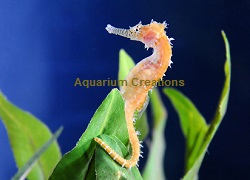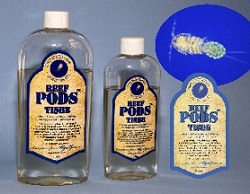Reidi Seahorse, Captive-Bred
Hippocampus Reidi
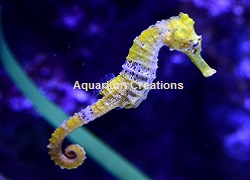
Youtube Video Hippocampus Reidi Seahorse Captive-Bred
Description:
The ever-popular Brazilian seahorses Hippocampus reidi are sleek, graceful animals, perfectly proportioned with slender bodies, long tails, and long snouts. Their appearance gives rise to their other common names, the slender seahorse or the long-snout seahorse. Whereas the robust H. erectus is solidly built, like a truck, H. reidi shares the graceful curves of a Corvette stingray. The result is an elegant warm-water seahorse that is an all-time favorite.
Long renowned for their brilliant colors, rapid color changes, prolific breeding habits, and huge broods of difficult-to-raise fry, all serious seahorse keepers are familiar with these breathtaking beauties. Often proclaimed the most attractive of seahorses, H. reidi is the crown jewel in many aquarists’ collections. These rather majestic steeds are long-lived, and with good care they will be your companions for the next 8 to 10 years, and may eventually reach a length of 8 inches. The Brazilian Seahorse (Hippocampus reidi) was initially introduced into the aquarium trade after being imported from Brazil in the past, this is actually an Atlantic Ocean species that occurs from as far north as the Carolinas, Bermuda, and south to Brazil. They have a range of color variations from black to yellow, orange and red. These seahorses are Captive-Bred and are available in the Yellow or Black color variant. The coloration may change in the aquarium and is highly dependent on the colors of its environment.
When ready to mate, the male Reidi Seahorse will show off for the female with dramatic color changes, pouch displays, and lots of special seahorse dancing. If receptive, the female will wrap her tail, dance along with the male, and then deposit as many as 600 eggs in the male's pouch. About 14 days later, the male will give birth to between 50-400 perfect miniature reidi seahorses.
Tank Conditions
The Reidi Seahorse Seahorse should ideally be kept in temperatures between 72 and 78 degrees Fahrenheit. A pH value of 8.1 or 8.4, and a specific gravity of 1.020 to 1.025 should be maintained. When kept with invertebrates, the specific gravity range should be 1.020 to 1.025, for the invertebrate species. In a fish only aquarium, the specific gravity should fall between 1.020 and 1.023
Tank Recommendations
These social swimmers thrive when kept either as a mated pair or as a group in a species only aquarium. For a pair a 30 gallon aquarium will do, for every two additional seahorses add 10 gallons to the minimum size. Seahorses may be kept with small, slow feeding fish such as smaller gobies, pipefish, dragonets, and firefish. Stay away from aggressive, territorial, and fast moving fish as they will not be good neighbors for the seahorse.
Food and Diet:
Our captive bred seahorses will thrive on frozen Brine shrimp and frozen mini mysis shrimp. They need to be fed at least 2 to 3 times a day. Their diet may be supplemented by amphipods and copepods found in the live rock. Adding a refugium to the aquarium will increase this food source greatly.
Looking for the best food to feed your Seahorses?
We recommend AlgaGen Reefpods Tisbe
Reef Compatability:
Yes
Level of Care:
Moderate
Acclimation time:
2+ hours
Approximate Purchase Size:
Medium 2" to 3" Large 3" to 4"
Medium Male $199.99
Medium Female $199.99
Large Male $259.99
Large Female $259.99
|
|
Tigertail Seahorse, Captive-Bred
Hippocampus comes
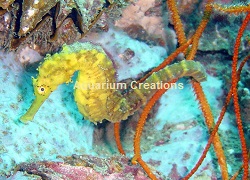
Video 1-1/2 Year Old Pair Hippocampus Comes Seahorse's
Description:
Named for its black and yellow striped tail, the tiger tail seahorse (Hippocampus comes) will grow to between 6 and 8 inches. It is an unusual-looking fish, with an upright posture, curved trunk, and grasping, prehensile tail. The head, which is positioned at right angles to the body, bears a long, tubular snout, and the eyes are able to swivel independently. Unusually for a fish, seahorses lack scales, and the skin is stretched over a serious of bony plates which appear as obvious rings around the trunk and tail. The dorsal fin is used for locomotion, and two small, ear-like pectoral fins are used for steering. The Males of the species are often blackish, while females are usually yellowish. Both have a camouflage of stripes and blotches with dramatic markings around the eyes. Young seahorses cling to swaying sargassum and macroalgae beds. Timid adults hide in coral reefs during the day, coming out to feed at night. The male carries the eggs in a brood pouch located under the tail. The coloration may change in the aquarium and is highly dependent on the colors of its environment.
The mating ritual of the Tigertail Seahorse is quite fascinating. When the male is ready to mate, he will present the female with a dance, color changes, blatant pouch displays, and active gyrations. If the female is receptive, she will entwine tails with the male, dance, and promenade with it, and then insert as many as 500 to 600 eggs in the male pouch. About two weeks later, the male gives birth to between 50 and 400 miniature duplicates of the pair.
Tank Conditions
The Tiger Tail Seahorse Seahorse should ideally be kept in temperatures between 72 and 78 degrees Fahrenheit. A pH value of 8.1 or 8.4, and a specific gravity of 1.020 to 1.025 should be maintained. When kept with invertebrates, the specific gravity range should be 1.020 to 1.025, for the invertebrate species. In a fish only aquarium, the specific gravity should fall between 1.020 and 1.023
Tank Recommendations
These social swimmers thrive when kept either as a mated pair or as a group in a species only aquarium. For a pair a 30 gallon aquarium will do, for every two additional seahorses add 10 gallons to the minimum size. Seahorses may be kept with small, slow feeding fish such as smaller gobies, pipefish, dragonets, and firefish. Stay away from aggressive, territorial, and fast moving fish as they will not be good neighbors for the seahorse.
Food and Diet:
Our captive bred seahorses thrive on frozen Brine shrimp and frozen mini mysis shrimp. They should be fed at least 2 to 3 times a day. Their diet may be supplemented by amphipods and copepods found in the live rock. Adding a refugium to the aquarium will increase this food source greatly.
Looking for the best food to feed your Seahorses?
We recommend AlgaGen Reefpods Tisbe
Reef Compatability:
Yes
Level of Care:
Moderate
Acclimation time:
2+ hours
Approximate Purchase Size:
2" to 3"
Unsexed $89.99
Female $99.99
Male $109.99
|
|
Banded Pipefish
Doryrhamphus dactyliophorus

Video of Banded Pipefish, Doryrhamphus dactyliophorus
Description:
The banded pipefish is also known as Ringed Pipefish. Its body is very sleek resembling more like an eel. The Red Banded Pipefish is one of the highly prized reef pipefish or flagtail pipefish from the tropical Indo-Pacific. It is a relative of the seahorse with a very long, slender, cylindrical body that resembles a colorful pipe cleaner (hence the name pipefish). This species is boldly marked, with dark reddish to maroon vertical rings running the length of its body and a very striking flag-like tail that is used to propel it horizontally through the water. The tail is a bright red oval with a brilliant white margin all around and a distinctive yellow mark in the center that is often shaped like a cube or rectangle rather than a round dot. This brilliant tail fin makes the Red Banded Pipefish a faster, stronger swimmer than its seahorse cousins and it rarely comes in direct contact with the substrate. Unlike the slowpoke seahorse, which moves through the water vertically (head up and tail down) with a stately, dignified swimming style, the Red Banded Pipefish propels itself horizontally through the water like a torpedo with powerful strokes of its oar-like tail and sinuous body when swimming. This fish is of peaceful nature. They pose no danger to other fishes. However, they are prone to attacks by aggressive fishes such as wrasses, tobies, triggerfish, porcupine fish etc. This species can grow up to 8 inches in length. Banded pipefish are live bearers that form mated pairs; they are pouch breeders (females attach their eggs to the brood patch on the underside of their mates and the males then carry the eggs and developing young until birth).
Tank Conditions
The Doryrhamphus dactyliophorus should ideally be kept in temperatures between 72 and 78 degrees Fahrenheit. The Ph balance of the water should also be maintained between 8.1 and 8.4 as they prefer alkaline content of the water to be high. The specific gravity should be maintained ideally between 1.020-1.025. Strive to provide them with multiple cave-like structures or overhangs in a well-planted aquarium with lots of colorful macroalgae that simulates their natural habitat and provides shelter for abundant population of copepods and amphipods.
Tank Recommendations
A well-planted "Fish-Only-with-Live-Rock" (FOWLR) seahorse setup or seahorse-safe reef tank is the ideal habitat for the Red Banded Pipefish. Plenty of live rock, lots of macroalgae, colorful artificial corals, or seahorse-safe soft corals are all very appropriate forms of decor. In the wild, these pipefish can be found swimming under rocky overhangs, corals, or close to the floor of its reef habitat, and in the aquarium they will appreciate live rock arrangements that form caves, arches, and overhanging ledges. (Pipefish will often swim upside down along the roof of a cave or overhang.) In a tank with lots of live rock and a thriving pod population, you may sometimes see the red banded pipefish slithering along the bottom of the tank in a very serpentine fashion, as it hunts for copepods and amphipods and all the nooks and crannies in the rockwork. Tankmates must be quite peaceful, as pipefish make good targets for fin-nipping species. FYI: This is a slow moving fish that can easily get sucked into an open intake siphon; therefore these type intakes must have a strainer on their intake areas.
Food and Diet:
The Red Banded Pipefish is a carnivore that needs a meaty diet but it's tiny, tubular mouth severely limits the size of the prey items it can consume. In the wild, its diet consists primarily of copepods and in the aquarium it will thrive in a well-established tank with lots of live rock and macroalgae that houses a large pod population. Hobbyists will find it convenient to supplement its diet with Algagen Tisbe, Bottled Live Copepods, which are an ideal food for this fastidious feeder. Over time, as it becomes accustomed to its new surroundings, the Red Banded Pipefish will be content eating non-living foods such as frozen CYCLOP-EEZE®, very small frozen Mysis, and Nutramar Ova.
When it comes to frozen food, stick with the smallest brands of frozen Mysis (e.g., Mini Mysis by H2O Life) and bars of frozen Cyclop-Eeze for best results. Bars of frozen Cyclop-Eze work especially well because they will shed copious amounts of the bite-size frozen cyclops. Brands of larger frozen Mysis can also be used for feeding the pipefish, and hobbyists tell me that their red banded pipes can even handle the jumbo Piscine Energetics frozen Mysis relicta, looking a bit like a sword swallower in the process, as they gradually gulp down the king sized Mysis shrimp in several bites. But the brands of bigger frozen Mysis often work better after they have been minced or shaved. The frozen Mysis that works best for most hobbyists when minced is Hikari in frozen blocks rather than trays. The Hikari Mysis is much smaller than Piscine Energetics Mysis relicta and that makes it easier to shave off bite-sized pieces for the pipefish. When it comes to shaving the Mysis, a technique that works well for many home hobbyists is to use a potato peeler to shave off bits of the Hikari Mysis from a frozen block, and then use a single edged razor blade to further mince the frozen bits the potato peeler has removed. Small, frequent feedings are best. Try to feed your pipefish at least three times daily and be careful not to overfeed at any single feeding, especially with the frozen Cyclop-eeze, which tends to be messy because significant amounts of it go uneaten.
Looking for the best food to feed your Pipefish?
We recommend AlgaGen Reefpods Tisbe
Reef Compatability:
Yes
Level of Care:
Moderate
Acclimation time:
2+ hours
Approximate Purchase Size:
3" to 5"
$39.99
|
|

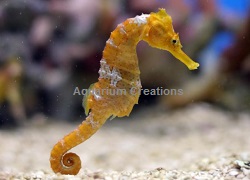 Captive-Bred Hippocampus Erectus Seahorse
Captive-Bred Hippocampus Erectus Seahorse

